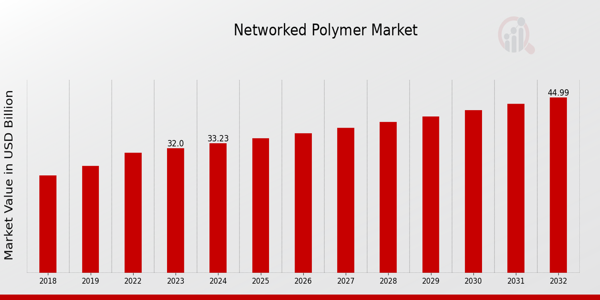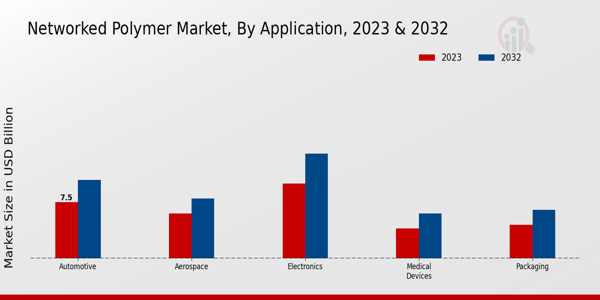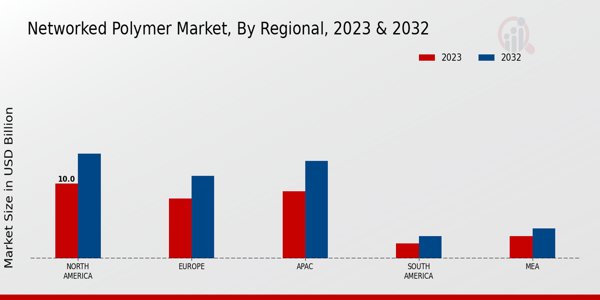Networked Polymer Market Overview
The Networked Polymer Market Size was estimated at 34.52 (USD Billion) in 2024. Networked Polymer Industry is expected to grow from 35.85 (USD Billion) in 2025 to 50.42 (USD Billion) by 2034, at a CAGR (growth rate) is expected to be around 3.90% during the forecast period (2025 - 2034)
Key Networked Polymer Market Trends Highlighted
The Networked Polymer Market is significantly driven by the increasing demand for lightweight and durable materials across various industries. The growing emphasis on sustainability and eco-friendly products is leading manufacturers to innovate in the production of polymers that are both advanced and environmentally friendly.
Additionally, the rise in automation and smart technologies in manufacturing processes enhances the efficiency of networked polymers, making them more appealing to businesses looking to streamline operations and reduce costs. Opportunities lie in the exploration of new applications for networked polymers, particularly in fields such as healthcare, automotive, and electronics.
The integration of these materials into wearable technology and smart textiles is expected to grow, paving the way for innovative products that require materials with unique properties. The evolution of biopolymers also presents a chance for companies to create sustainable alternatives that cater to environmentally conscious consumers.
Recent trends indicate a shift toward the use of recycled materials in the production of networked polymers, reflecting a broader industry movement aimed at reducing waste and promoting a circular economy.
Investment in research and development is rising as companies seek to enhance the performance characteristics of polymers while decreasing their environmental footprint.
Furthermore, the advancement of digital technologies is enabling the creation of smart polymers that respond to environmental changes, opening up new possibilities for functionality and application.
This combination of technological advancement and sustainability focus suggests a promising future for the Networked Polymer Market.

Source: Primary Research, Secondary Research, MRFR Database and Analyst Review
Networked Polymer Market Drivers
Rising Demand for Lightweight and High-Performance Materials
The Networked Polymer Market is witnessing significant growth due to the escalating demand for lightweight and high-performance materials across various sectors. Industries such as automotive, aerospace, and construction are increasingly prioritizing efficiency, sustainability, and performance in their material choices.
As environmental regulations become more stringent and the focus on reducing carbon footprints grows, manufacturers are leaning towards materials that offer both weight reduction and high strength-to-weight ratios.
Networked polymers, with their innovative properties, fit this need perfectly, enabling companies to enhance fuel efficiency in vehicles and reduce energy consumption in structural applications. The advancements in polymer science have led to the development of composites that not only meet but exceed traditional materials in terms of performance, expanding their application range.
Furthermore, the integration of nanotechnology with polymer materials is introducing new functionalities that are fostering innovation while ensuring that the products are lightweight yet sturdily built.
The ongoing research and development efforts aim to optimize the use of networked polymers, ensuring they can withstand demanding conditions while providing manufacturers with a competitive edge. As industries increasingly recognize the benefits of using these advanced materials, the market for networked polymers is anticipated to expand significantly, driving future growth in the sector.
Technological Advancements in Polymer Processing
Innovations in polymer processing technologies are one of the crucial drivers for the Networked Polymer Market. These advancements are paving the way for the creation of complex structures with enhanced properties that were not achievable with traditional techniques.
Emerging methods such as 3D printing and injection molding are enabling manufacturers to produce intricate designs with precision, leading to improved performance and functionality.
Furthermore, the integration of automation and computer-aided design (CAD) is streamlining the production process, reducing lead times and costs. As these technologies continue to evolve, the ability to customize networked polymers for specific applications will provide significant competitive advantages to manufacturers, fostering a vibrant environment for market growth.
Growing Applications in Diverse Industries
The versatility of networked polymers is driving their adoption in a variety of industries, thereby propelling the Networked Polymer Market forward. These materials are finding applications in sectors such as electronics, healthcare, and consumer goods, among others.
In the electronics industry, for instance, networked polymers are used to manufacture lightweight and durable components that enhance the performance of devices. Similarly, in healthcare, they are employed in the production of biocompatible devices, improving patient safety and outcomes.
This widespread applicability not only broadens the market scope but also leads to ongoing innovation as industries seek tailored solutions for their specific needs, ensuring sustained growth in the market.
Networked Polymer Market Segment Insights
Networked Polymer Market Application Insights
The Networked Polymer Market is experiencing significant growth within the Application segment. A major aspect of this growth can be attributed to diverse applications in various industries, with specific emphasis on Automotive, Aerospace, Electronics, Medical Devices, and Packaging.
In 2023, the Automotive Application was noted to hold a value of 7.5 USD billion, illustrating the industry's increasing demand for lightweight, durable materials that enhance fuel efficiency and safety performance in vehicles.
The Aerospace sector followed closely, valued at 6.0 USD billion in 2023, as innovations in materials that withstood extreme conditions become crucial for advancing aircraft design and performance.
The Electronics Application led with a valuation of 10.0 USD billion in 2023, driven by the rapid evolution of consumer electronics and the need for advanced materials that ensure high performance and longevity. This sector's dominance demonstrated its critical role in technological advancements and manufacturing processes.
The Medical Devices Application was valued at 4.0 USD billion, highlighting the rising need for biocompatible polymers and materials that support patient safety and effective drug delivery systems.
Furthermore, the Packaging industry, valued at 4.5 USD billion, reflected a growing emphasis on sustainable materials and innovative designs to meet the global demand for reduced environmental impact and product durability.
As part of the Networked Polymer Market statistics, these applications signify strong growth drivers that cater to modern needs across various sectors. The expected market growth is fueled by advancements in polymer technologies and increasing consumer awareness of material performance and sustainability.
However, challenges such as raw material costs and regulatory issues around product safety and environmental impact persist. The market data reveals substantial opportunities, particularly for companies innovating in materials that combine performance with eco-friendliness to address shifting consumer preferences.
Overall, the Application segment of the Networked Polymer Market demonstrates a robust landscape where interconnected polymers are reshaping industries and driving forward advancements in technology and sustainability.

Source: Primary Research, Secondary Research, MRFR Database and Analyst Review
Networked Polymer Market Material Type Insights
The Networked Polymer Market has shown notable interest in the Material Type segment, which encompasses various forms such as Thermoplastics, Thermosets, Elastomers, and Biopolymers. Thermoplastics, known for their versatility and recyclability, comprise a significant portion of the market, catering to diverse applications across industries.
Meanwhile, Thermosets are valued for their thermal and mechanical stability, making them a preferred choice in sectors like automotive and aerospace, thereby dominating in terms of high-performance applications.
Elastomers, with their unique elastic properties, find extensive usage in consumer goods and industrial purposes, further illustrating their prominence. Biopolymers present exciting opportunities in sustainability, as they are derived from renewable sources and meet the increasing demand for eco-friendly materials.
The segmentation of the Networked Polymer Market offers insights into growth drivers, such as innovations in polymer processing and increasing environmental regulations that bolster the market growth. However, challenges like fluctuating raw material prices and competition from alternative materials pose a risk to expansion.
Overall, the material types within this market reflect diverse applications, technological advancements, and evolving consumer preferences, showcasing a robust future for the industry.
Networked Polymer Market End Use Industry Insights
The Networked Polymer Market showcases a diverse range of applications across various end use industries, including Consumer Goods, Healthcare, Construction, and Transportation. The Consumer Goods sector represents a significant portion of market utilization, driven by increasing demand for advanced packaging solutions that enhance product shelf life and safety.
In Healthcare, the market is gaining traction due to the rise of medical devices and drug delivery systems, leveraging networked polymer technologies for improved performance. The Construction industry benefits from enhanced durability and energy efficiency offered by these materials, effectively addressing modern infrastructural demands.
Transportation also plays a crucial role in the market, as the push for lightweight and fuel-efficient vehicles drives innovation in material development. The Networked Polymer Market segmentation reflects the industry's adaptability and potential for growth amidst evolving consumer behaviors and regulatory landscapes.
Overall, these segments illustrate the compelling opportunities for market expansion, engaging various stakeholders and fostering advancements in polymer technology.
Networked Polymer Market Process Technology Insights
The Networked Polymer Market focuses on the Process Technology segment, exhibiting a robust growth trajectory.
The Process Technology segment encompasses various methods, with Injection Molding being one of the most significant techniques due to its efficiency in mass production and versatility in creating complex shapes. 3D Printing is gaining traction as it revolutionizes the manufacturing process, allowing for greater design freedom and customization.
Extrusion technology remains critical for producing continuous profiles and sheets catering to diverse industry needs. Lastly, Blow Molding is important in producing hollow plastic parts, significantly contributing to packaging solutions.
The combination of these methodologies not only drives market growth but also highlights the Networked Polymer Market revenue potential through enhanced innovation and manufacturing capabilities.
The market faces challenges such as environmental concerns and material sustainability; however, opportunities for technological advancements and eco-friendly processes continue to shape its future landscape.
Overall, the Networked Polymer Market remains dynamic, bolstered by emerging trends in Process Technology.
Networked Polymer Market Regional Insights
North America led the market with a valuation of 10.0 billion USD in 2023, expected to rise to 14.0 billion USD in 2032, showcasing its dominant role in networked polymer applications due to strong industrial demand. Europe followed closely, holding a revenue of 8.0 billion USD in 2023 and growing to 11.0 billion USD by 2032, benefitting from advancements in technology and R initiatives.
The APAC region also presented a robust opportunity with a valuation of 9.0 billion USD in 2023, likely increasing to 13.0 billion USD by 2032, driven by rapid industrialization and rising consumer demand. Meanwhile, South America held a smaller but significant share with revenues of 2.0 billion USD in 2023, expected to reach 3.0 billion USD by 2032, indicating an emerging market landscape.
Lastly, the Middle East and Africa (MEA) region, although smaller in scale, showed potential, with a growth from 3.0 billion USD in 2023 to 4.0 billion USD by 2032, reflecting increasing investments in polymer technologies throughout the region.
Overall, the Networked Polymer Market data reflected diverse opportunities across these regions, influenced by market trends, growth drivers, and the unique challenges pertaining to each area's demands and applications.

Source: Primary Research, Secondary Research, MRFR Database and Analyst Review
Networked Polymer Market Key Players and Competitive Insights:
The Networked Polymer Market is experiencing a transformative phase, marked by rapid technological advancements and increasing application across various industries such as automotive, construction, and electronics.
This market is characterized by a blend of traditional polymer products and innovative, interconnected solutions that leverage IoT and digital technologies. Competitive insights reveal a dynamic landscape where companies are continually evolving their product offerings and engaging in strategic collaborations to enhance their market position.
As demand for high-performance polymers grows, players are focusing on sustainability and efficiency, driving research and development efforts that aim at enhancing product performance while reducing environmental impacts.
Covestro stands as a prominent entity within the Networked Polymer Market, showcasing a robust capacity for innovation and sustainability. The company emphasizes the development of advanced polymer solutions that cater to multiple sectors, particularly in creating intelligent materials that integrate seamlessly with digital technologies.
Covestro's commitment to circular economy principles is evident in its continuous efforts to produce high-quality polymers from renewable resources and its engagement in recycling initiatives.
Their extensive research capabilities, along with a diverse portfolio of products, position Covestro as a strong competitor, enabling them to effectively meet the evolving needs of customers while staying ahead of trends.
Furthermore, Covestro's strategic partnerships enhance its reach in the market, allowing the company to expand its presence and influence within the networked polymer segment.
LG Chem is also a vital player in the Networked Polymer Market, recognized for its significant investments in research and technological developments aimed at pioneering advanced polymer solutions.
The company's expertise lies in polyester and polyamide materials, which are increasingly being utilized across various applications that require connectivity and smart functionalities. LG Chem emphasizes innovation aligned with sustainability, dedicating resources to develop eco-friendly products that minimize environmental harm while maximizing performance.
The company's strong focus on research allows it to remain competitive, as it regularly introduces new materials that respond to market demands for efficiency and adaptability. With its established global presence, LG Chem continues to strengthen its foothold through strategic initiatives, which are aimed at expanding its influence within the market and catering effectively to the demands of diverse industries.
Key Companies in the Networked Polymer Market Include
- Covestro
- LG Chem
- Ferro Corporation
- Solvay
- 3M
- DuPont
- BASF
- Lanxess
- Toray Industries
- ExxonMobil
- Dow
- Eastman Chemical
- Asahi Kasei
- SABIC
- Mitsubishi Chemical
Networked Polymer Market Developments
Recent developments in the Networked Polymer Market have highlighted significant advancements and collaborations among key players such as Covestro, LG Chem, and BASF. These companies are increasingly focusing on sustainable practices and innovative product solutions to address growing environmental concerns.
For instance, Solvay has been enhancing its portfolio with bio-based polymers, while 3M is investing in technology to improve polymer performance and recyclability.
Current affairs have also seen a surge in the strategic initiatives by DuPont and Eastman Chemical to expand their market reach through new product lines in engineering polymers, which are vital for industrial applications.
Recent mergers and acquisitions have further shaped the market dynamics, with several companies like Mitsubishi Chemical and SABIC exploring strategic partnerships to expand their capabilities. Notable movements include Lanxess's acquisition of high-performance additive technologies, which bolster its position in specialty polymers.
The overall growth in market valuation among these companies reflects a robust demand for high-performance materials across diverse applications, influencing both pricing strategies and production capacities in the networked polymer landscape.
Networked Polymer Market Segmentation Insights
Networked Polymer Market Application Outlook
- Automotive
- Aerospace
- Electronics
- Medical Devices
- Packaging
Networked Polymer Market Material Type Outlook
- Thermoplastics
- Thermosets
- Elastomers
- Biopolymers
Networked Polymer Market End Use Industry Outlook
- Consumer Goods
- Healthcare
- Construction
- Transportation
Networked Polymer Market Process Technology Outlook
- Injection Molding
- 3D Printing
- Extrusion
- Blow Molding
Networked Polymer Market Regional Outlook
- North America
- Europe
- South America
- Asia Pacific
- Middle East and Africa
|
Report Attribute/Metric
|
Details
|
|
Market Size 2024
|
34.52 (USD Billion)
|
|
Market Size 2025
|
35.85 (USD Billion)
|
|
Market Size 2034
|
50.42 (USD Billion)
|
|
Compound Annual Growth Rate (CAGR)
|
3.90% (2025 - 2034)
|
|
Report Coverage
|
Revenue Forecast, Competitive Landscape, Growth Factors, and Trends
|
|
Base Year
|
2024
|
|
Market Forecast Period
|
2025 - 2034
|
|
Historical Data
|
2020 - 2024
|
| Market Forecast Units |
USD billion |
| Key Companies Profiled |
Covestro, LG Chem, Ferro Corporation, Solvay, 3M, DuPont, BASF, Lanxess, Toray Industries, ExxonMobil, Dow, Eastman Chemical, Asahi Kasei, SABIC, Mitsubishi Chemical |
| Segments Covered |
Application, Material Type, End Use Industry, Process Technology, Regional |
| Key Market Opportunities |
Sustainable materials development, Smart packaging solutions, Advanced medical applications, IoT integration in manufacturing, Energy-efficient polymer technologies |
| Key Market Dynamics |
Rising demand in electronics, Enhanced durability and performance, Growing applications in healthcare, Increasing sustainability focus, Advancements in manufacturing technologies |
| Countries Covered |
North America, Europe, APAC, South America, MEA |
Frequently Asked Questions (FAQ) :
The Networked Polymer Market is projected to be valued at 50.42 USD billion by 2034.
The expected CAGR for the Networked Polymer Market from 2025 to 2034 is 3.90%.
North America held the largest market share in the Networked Polymer Market for 2023, valued at 10.0 USD billion.
The market size for the Automotive application in the Networked Polymer Market is expected to reach 10.5 USD billion by 2032.
Major players in the Networked Polymer Market include Covestro, LG Chem, and DuPont, among others.
The market size for the Electronics application in the Networked Polymer Market is projected to be 14.0 USD billion by 2032.
The Networked Polymer Market in Europe is expected to be valued at 11.0 USD billion by 2032.
The expected market value for the Medical Devices application in the Networked Polymer Market is 6.0 USD billion by 2032.
The South American market for Networked Polymers is expected to grow to 3.0 USD billion by 2032.
The Packaging segment in the Networked Polymer Market is projected to reach 6.5 USD billion by 2032.

















